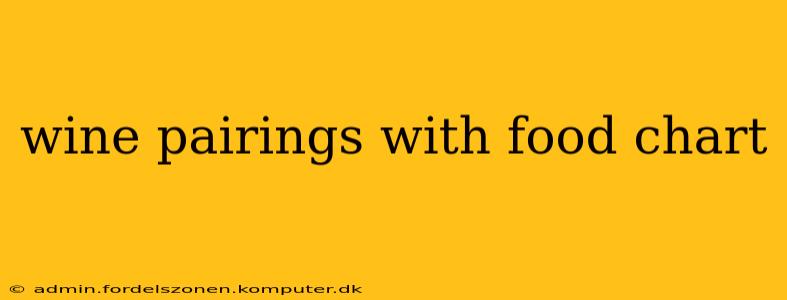Wine pairing can seem daunting, but with a little understanding, it becomes an enjoyable art. This guide offers a comprehensive chart and explanations to help you navigate the world of wine and food pairings with confidence. The key is to find complementary flavors and textures, creating a harmonious culinary experience.
Understanding the Basics of Wine Pairing
Before diving into specific pairings, let's establish some fundamental principles:
-
Weight and Body: Generally, lighter wines pair well with lighter dishes, and fuller-bodied wines complement richer foods. A delicate white wine wouldn't stand up to a hearty steak, just as a robust red wine might overpower delicate seafood.
-
Acidity and Fat: High acidity in wine cuts through richness and fat in food. This is why crisp white wines often pair well with fatty fish or creamy sauces.
-
Tannins and Protein: Tannins, found in red wines, bind with proteins in meat, creating a pleasing mouthfeel. This is why red wines are often a classic choice for steak or lamb.
-
Sweetness and Spice: Sweet wines can balance spicy dishes, while dry wines can enhance savory flavors.
Wine Pairing Chart: A Quick Reference
This chart provides a starting point for your wine pairing adventures. Remember, these are suggestions, and personal preference always plays a role!
| Food Category | Wine Suggestion | Notes |
|---|---|---|
| Appetizers | Sparkling wine, light-bodied white wine | Crisp acidity cleanses the palate. |
| Shellfish (Oysters, Clams) | Sparkling wine, dry rosé, Chablis | High acidity cuts through the briny taste. |
| White Fish (Cod, Halibut) | Sauvignon Blanc, Pinot Grigio, Vermentino | Light-bodied whites with bright acidity. |
| Fatty Fish (Salmon, Tuna) | Chardonnay (unoaked), Pinot Blanc, Rosé | Richer whites or rosés that can handle the fattiness. |
| Chicken | Pinot Noir, Chardonnay, Sauvignon Blanc | Versatile, depending on the preparation. |
| Pork | Pinot Noir, Riesling (off-dry), Rosé | Pair with the fattier cuts with a fuller-bodied wine. |
| Beef (Red Meat) | Cabernet Sauvignon, Merlot, Zinfandel | Full-bodied reds with tannins to complement the protein. |
| Lamb | Cabernet Sauvignon, Merlot, Rioja | Hearty reds that stand up to the richness of lamb. |
| Cheese (Soft) | Sauvignon Blanc, Pinot Grigio | Lighter whites with bright acidity. |
| Cheese (Hard) | Cabernet Sauvignon, Merlot, Zinfandel | Full-bodied reds that pair well with the intensity of the cheese. |
| Dessert (Fruit-Based) | Riesling (sweet), Moscato, Sauternes | Sweet wines that complement the sweetness of the dessert. |
| Dessert (Chocolate) | Port, Ruby Port, Cabernet Sauvignon (dessert style) | Rich, sweet wines that can handle the intensity of chocolate. |
Frequently Asked Questions (FAQs)
What are some good wine pairings for pasta?
Pasta dishes vary widely. Lighter pasta dishes with pesto or tomato sauce pair well with Pinot Grigio or Sauvignon Blanc. Creamier pasta dishes, especially with richer sauces, may benefit from a light-bodied Chardonnay or even a Pinot Noir. Pasta with red meat ragu calls for a full-bodied red like Chianti or Merlot.
What wine goes best with pizza?
The best wine for pizza depends on the toppings. A simple Margherita pizza pairs beautifully with a light-bodied red like a Pinot Noir or a crisp white like a Pinot Grigio. For richer pizzas with meat or spicy toppings, a bolder red like a Chianti or a dry rosé might be a better choice.
What is the best wine for Thanksgiving dinner?
Thanksgiving dinner typically includes a variety of dishes, so choosing one wine can be tricky. A versatile choice is Pinot Noir, which pairs well with turkey, stuffing, and many side dishes. Alternatively, a medium-bodied Chardonnay or a light-bodied red blend could also work.
How do I choose wine for a spicy dish?
Spicy food often benefits from slightly sweet wines or those with high acidity to balance the heat. Off-dry Riesling, Gewürztraminer, or even a fruity rosé can be excellent choices. The sweetness helps to neutralize the capsaicin in chili peppers.
Can I use a wine pairing chart for all occasions?
While a wine pairing chart provides a great starting point, remember that personal preference and the specific flavors and ingredients in your dish are paramount. Don't be afraid to experiment and find pairings that you enjoy!
This guide aims to provide a solid foundation for your wine pairing journey. Remember that exploration and experimentation are key to discovering your personal favorite pairings. Enjoy!
